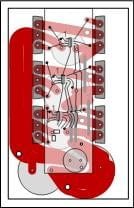Alan B
100 GW
Avnet shipped the CPUs already!
Jeremy Harris said:If you're going for TO247 FETs then the two best ones that are readily available are the IRFP4368 (for up to around 65-70V working voltage) or the IRFP4468 (for up to around 90-95V working voltage).
The IRFP4368 has an Rdson of around 3mohm at 100 deg C junction temperature, and has reasonably good thermal conductivity from the junction to the heatsink (probably the most critical parameter). It should be OK for up to around 100A or so reliably.
There are other TO247 packages about, but these two are both easy to buy and have pretty good specs. The downside is the price, but that will come down a lot for a group buy direct from IR.
Jeremy

For what you're thinking, would make for a very compact unit.Alan B said:Instead of putting the processor between the FETs I am thinking of putting the capacitors between the FETs and putting the processor/etc on a board below the FET PCB. Wonder if caps can be kept short enough to match the TO247 FET height. They are pretty tall anyway.
Alan B said:What is the copper weight on those traces. Nevermind, you said 3 oz. Thanks.
Jeremy Harris said:If you're going for TO247 FETs then the two best ones that are readily available are the IRFP4368 (for up to around 65-70V working voltage) or the IRFP4468 (for up to around 90-95V working voltage).
texaspyro said:Jeremy Harris said:If you're going for TO247 FETs then the two best ones that are readily available are the IRFP4368 (for up to around 65-70V working voltage) or the IRFP4468 (for up to around 90-95V working voltage).
The IRFP2907 is another one to look at. Rds is spec'd at 4.5 milliohms, but they actually run 3 milliohms. Can be had for 3 bucks a pop. I use them in my welder and rocket launch controllers.
Nice FETS!Jeremy Harris said:If you're going for TO247 FETs then the two best ones that are readily available are the IRFP4368 (for up to around 65-70V working voltage) or the IRFP4468 (for up to around 90-95V working voltage).
The IRFP4368 has an Rdson of around 3mohm at 100 deg C junction temperature, and has reasonably good thermal conductivity from the junction to the heatsink (probably the most critical parameter). It should be OK for up to around 100A or so reliably.
There are other TO247 packages about, but these two are both easy to buy and have pretty good specs. The downside is the price, but that will come down a lot for a group buy direct from IR.
Jeremy
